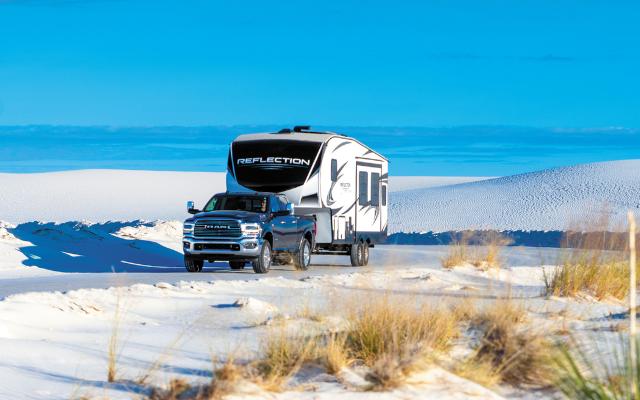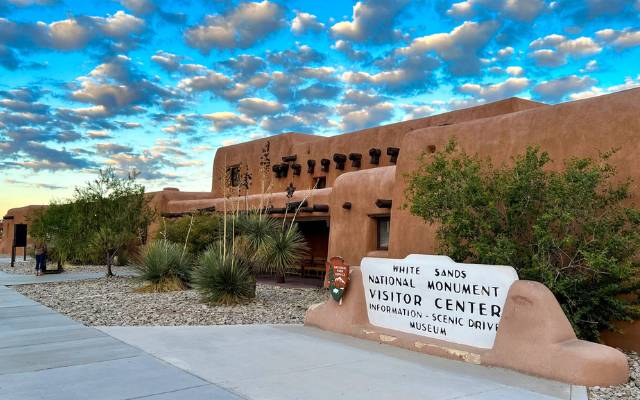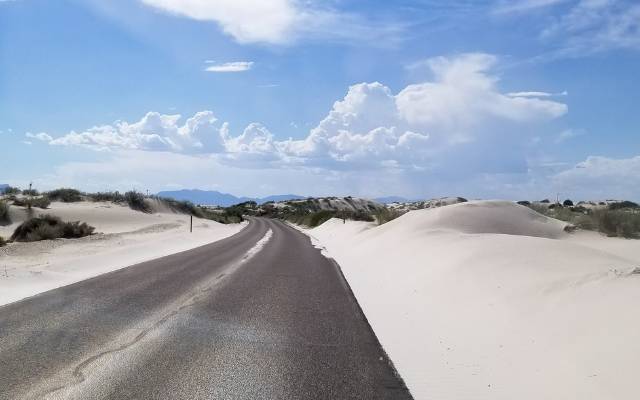

RV White Sands National Park
By Bruce W. Smith
Originally published in Family RVing September/October 2024 Issue
With its shifting, shimmering gypsum sand dunes, this southern New Mexico treasure is one of a kind.
RVing to White Sands National Park and watching the sun slowly rise over the Sacramento Mountains and bathe the snow-white sand dunes that surround me in a soft, golden glow is an amazing sight. The sand beneath my feet is surprisingly firm and cool, and the fresh, crisp morning air — carrying the scent of fragrant Chihuahuan Desert plants and shrubs — is invigorating.
In minutes, the orange tint fades, the few popcorn clouds disappear, and the late fall sun shines brightly upon mile after mile of striking dunes that stretch west to the base of the San Andres Mountains and cover 275 square miles of this stunning New Mexico valley. There’s no other place on Earth like White Sands National Park.
The park is located in the Tularosa Basin of south-central New Mexico. Its southern edge lies on the north side of U.S. 70 between Alamogordo and Las Cruces — and it’s surrounded by the White Sands Missile Range.
This expansive park covers 145,762 acres. It protects the southern 41 percent of these stunning white sand dunes composed of fine grains of gypsum; the remainder is part of the missile range. This gypsum dunefield is the largest of its kind on Earth, with an average depth of 30 or so feet and dunes that reach 60 feet high, according to information found in the park’s visitor center. This facility marks the only entry point from which to explore the world wonder.
Looking for RV camping near White Sands National Park? Check out Hacienda RV Resort in Las Cruces or Alamogordo/White Sands KOA Journey.
How were the dunes created?
When it comes to desert sand and sand dunes in general, gypsum sand is unique. Geologists say the gypsum that forms this enormous dunefield is deposited in this part of the Chihuahuan Desert by the strong southwesterly winds that constantly blow across Lake Lucero and Alkali Flat, the dry lake bed of ancient Lake Otero.
Large spring floods hit this region every 10 to 14 years, washing more gypsum down from the surrounding mountains and into the lake and the ancient lake bed. There, as has happened for tens of thousands of years, wind and sun dry out the gypsum-laden water and deposit the white particles in White Sands.
Best time to visit White Sands National Park in an RV
White Sands National Park is open year-round. But RVers who want to get the most enjoyment out of a stop here should plan their trip for the fall. My wife and I timed our White Sands visit in October, when the southwestern desert temperatures average between 65 and 80 degrees Fahrenheit during the day, the constant winds are at their lightest, and conditions are optimal for hiking and exploring.

If your travel plans bring you to White Sands in the spring and summer, be prepared to handle daytime temps averaging 95 to 110 degrees, plus high winds in May and June. In this part of New Mexico, the rainy season occurs from July through September, with late-afternoon and evening thunderstorms common in the area and accounting for the majority of the park’s annual 10 inches of precipitation.
Need a Place to Stay on the Way? Use the RV Overnights app to find unique, member-recommended spots en route to White Sands National Park. FRVA members get exclusive access and pricing. Not a member? Join Family RV Association now to unlock RV Overnights and more.
White Sands Visitor Center
The White Sands visitor center complex is composed of “Pueblo Revival”-style adobe buildings. Built between 1936 and 1940, they were designated as the White Sands Historic District in 1990. The gift shop and store are small but well-staffed and crammed with a plethora of information on all aspects of one of America’s newest national parks, including brochures, books, maps, and photos, as well as water and snacks.

A 17-minute movie titled A Land In Motion is shown every 30 minutes in the theater and provides great insight into the history, flora, and fauna of this desert attraction. Before you drive out to the dunes, the movie is a must-see to gain a better appreciation of how nature adapts to this ever-changing environment.
It’s just a few hundred yards to the visitor center from the park entrance, where you pay the $25 vehicle entrance fee or show an America the Beautiful interagency pass. This is the start of Dunes Drive.
An easy road trip
Dunes Drive is the only road into White Sands. This eight-mile-long two-laner is flat and paved for the first three miles, then abruptly transitions to hard-packed gypsum sand with the accompanying potholes, bumps, washboard sections, and occasional sand drifts. The road dead-ends eight miles in, where it loops back on itself.

We found Dunes Drive to be a safe, easy drive for motorhomes, camper vans, and vehicles towing trailers, because there are lots of pullouts and numerous large parking areas along the route. Grab a map of the road (or download it from the White Sands website) and head in, absorb the sights, take a hike, or have a picnic. The drive to the end and back to the entrance takes about 45 minutes with no stops.
One-of-a-kind dune trekking
While the sands that make up such places as the Oregon Dunes National Recreation Area, Utah’s Coral Pink Sand Dunes, Michigan’s Sleeping Bear Dunes, and the Great Sand Dunes of Colorado are very difficult to traverse on foot, White Sands is just the opposite.
The gypsum crystals that make up the White Sands dunefield compact nicely, making it rather easy to climb and explore, or to take a plastic saucer and slide down the steeper dune faces (sledding saucers – and wax – can be purchased at the visitor center). In fact, the National Park Service has established five marked hiking trails within the park.
The 0.4-mile-long round-trip Interdune Boardwalk Trail is the easiest and shortest of the five, and its elevated boardwalk is fully accessible for people using wheelchairs. The Alkali Flat Trail, located at the end of the road before it loops back, is the most difficult, measuring five miles long round trip and rated “strenuous” because it traverses multiple steep dunes.

The Alkali Flat Trail also provides the best photo opportunities of the tallest dunes, nicely backdropped by the San Andres Mountains. Maps of the White Sands trails can be picked up at the visitor center or accessed online.
We spent an entire morning checking out the park, hiking a couple of the trails, watching families sledding down the snow-white dunes, and having a late-morning picnic at the Roadrunner Picnic Area. The unusually shaped metal picnic shelters, with free-standing grills, are positioned to provide a little respite from the desert sun and wind.
Taking the short side trip off U.S. 70 in New Mexico to RV White Sands National Park is one of those wonderful RVing experiences that will be etched in our minds forever.
More info
Entry fee: $25 per private vehicle; can also use an America the Beautiful National Parks and Federal Recreation Lands Pass. Visit the White Sands National Park website for more info about passes.
Getting there: The entrance into White Sands National Park is located off U.S. 70 just 15 miles from Alamogordo and about 52 miles from Las Cruces. For visitors driving from Las Cruces, the entry to the park is on the left side of the highway about one mile past the Border Patrol checkpoint.
Hours, Road Closures: The park is open daily year-round from 7:00 a.m. to one hour after sunset; closing time changes with the season. The park is closed on Thanksgiving and Christmas Day. In addition, because the Dunes Drive into the park and U.S. 70 are adjacent to White Sands Missile Range, both occasionally will be closed for up to three hours if missile testing is in progress. Check the White Sands National Park closure page for such notifications (nps.gov/whsa/planyourvisit/park-closures.htm).
Other details: Visitors may bring their own sleds for the sand dunes; sleds and wax also can be purchased in the visitor center. As in other national parks, drone use is prohibited.
Want more stories like this?
Family RVing magazine is just one of the many benefits of joining Family RV Association. Members receive bi-monthly issues (available in print or digital) filled with expert tips, real RV travel stories, and must-see destinations. If you own (or want to own) an RV, this is the one RV magazine you’ll want to read.


Leave a Reply